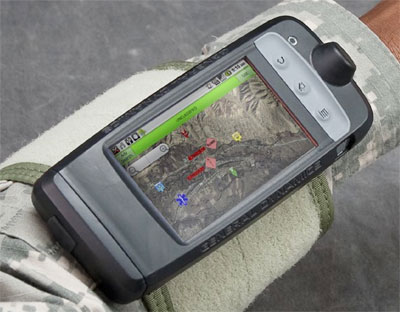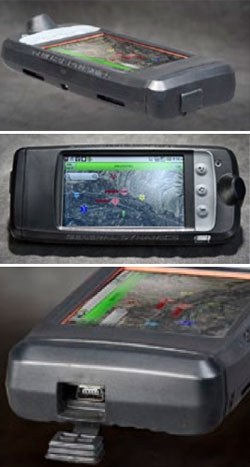Rugged wearable computer with GPS and tactical radio interface rolled out by GD Itronix
Sep 1, 2010
By John Keller
SUNRISE, Fla.–Rugged computer specialist General Dynamics Itronix in Sunrise, Fla., is introducing the GD300 wearable computer that combines satellite navigation, data communications, and battlefield-rugged computing to enhance situational awareness for the foot soldier.
The GD300 has a sensitive, commercial global positioning system (GPS), ARM Cortex A8 microprocessor, Android operating system, 3.5-inch color sunlight-readable display, and radio interface kit in an 8-ounce package that infantrymen can wear on their wrists or chests, or carry in the pockets of their battlefield gear.
The radio interface kit enables users to connect the computer with tactical radios like the AN/PRC-154 Rifleman Radio, which is a software-defined radio system that complies with the U.S. military's Joint Tactical Radio System (JTRS) architecture.
 |
| General Dynamics Itronix is merging radio technology with wearable computers in its GD300 for infantry soldiers. |
Once the GD300 is connected to a tactical radio, the user can exchange text, imagery, and other data with others on the battlefield, as well as gain access to the Tactical Internet to access streaming video from unmanned aerial vehicles and other intelligence, surveillance, and reconnaissance (ISR) assets.
The radio interface kit docks onto the bottom of the GD300 wearable computer. "As radio networks change, the computer does not have to be replaced," explains Jason Jacob, product manager of the GD300 at General Dynamics Itronix. "You can just modify the radio interface kit itself."
The Android operating system enables the GD300 to add and delete commercial and military software programs, including the Tactical Ground Reporting System (TIGR) Web-based information management application from General Dynamics C4 Systems in Fairfax, Va.
In addition to the sunlight-readable display, the GD300 has a night-vision appliqué so that users can read the screen at night while wearing night-vision goggles, Jacob describes.
"The screen is a regular transmissive display that uses a resistive touch screen designed with gloved fingers in mind," Jacob says. "This is fully rugged and lightweight, and there are not a lot of devices out there that are only half a pound and still fully rugged."
For additional information, visit General Dynamics Itronix online at www.gd-itronix.com.
Android-based rugged wearable computer/GPS/communicator
(by Conrad H. Blickenstorfer)
In early August of 2010, General Dynamics Itronix announced the GD300, a small wearable computer that combines rugged computing, GPS and data communication into one device specifically designed to provide access to tactical networks and enhance situational awareness. Interestingly, the GD300 runs the Android OS, making it probably the first ruggedized device from a major provider to use Android instead of Windows CE/Mobile.

The GD300 also differs from WinMo devices in its processing architecture. Instead of a Marvell PXA chip, the GD300 uses a 600MHz ARM Cortex-A8 core, a chip based on the ARMv7 architecture that can be scaled from 600MHz to over 1GHz. It's extremely power-frugal and designed for devices that must use less than 0.3 watts. The chip delivers 2.0 Dhrystone MIPS, and is the same core used in the Palm Pre and the Nokia N900.
 The unit has a 3.5-inch sunlight-viewable display with a resistive touch screen, and can also be configured to work with night vision goggles. Display resolution is 800 x 480 pixel, which translates into an exceptionally high resolution of 267 dpi (dots per inch). The whole assembly measures 5.8 x 2.6 x 0.7 inches and weighs just eight ounces. It can either be carried in a pocket or worn on the wrist or another part of the body.
The unit has a 3.5-inch sunlight-viewable display with a resistive touch screen, and can also be configured to work with night vision goggles. Display resolution is 800 x 480 pixel, which translates into an exceptionally high resolution of 267 dpi (dots per inch). The whole assembly measures 5.8 x 2.6 x 0.7 inches and weighs just eight ounces. It can either be carried in a pocket or worn on the wrist or another part of the body.
Radio in a military unit is different; the GD300's radio interface kit, which connects to the bottom of the GD300, is designed to work within the US military's joint Tactical Radio System (JTRS) architecture for data communication and network access, offering access to a secure, jam-resistant communications network used for almost real-time tactical information. The unit comes with integrated SIRF Star III GPS and a high-gain quadrifilar-helix antenna.
On the ruggedness side, General Dynamics tested the GD300 to pass the requisite testing procedures outlined in MIL-STD 810G for impact, dust ingress, rain/water ingress, vibration and shock, extreme temperatures and humidity. The initial specs, however, did not include specifics other than mentioning IP54 sealing.
According to web references, the base price of a GD300 is about US$1,200, which is modest for a ruggedized device geared towards military use. As of now, the most remarkable aspect of the GD300 is its use of the Android OS. The GD300 brochure points out that with Android, the device "easily accommodates current and emerging applications for warfighters at all command levels." That is so, but it also makes the GD300 the first device in a post-Windows Mobile era where Microsoft's mini-OS no longer rules supreme.
With 60 radios in play at White Sands, the HMS JTRS office got its best look at the program earlier this year. Using ground radios and an aerial tier that included Apache and Black Hawk helicopters, in addition to the Shadow unmanned aerial vehicle, soldiers were able to communicate over a distance of nearly 20 miles using the Soldier Radio Waveform and Rifleman radio. The Manpack radio also communicated over that distance, but it could do so without the need for an aerial tier.
The HMS JTRS office is working to earn Milestone C and low-rate initial production for the Rifleman radio before the end of fiscal 2011.
Other communications technologies demonstrated during White Sands included the HMS JTRS Small Form Fit radio that was integrated into unattended ground sensors at the terrestrial tier, and Shadow UAV and UH-60 Black Hawk and Apache helicopters at the aerial tier; as well as the Command Post of the Future (CPOF) and Tactical Ground Reporting (TIGR) software applications to equip command posts with command and control capabilities traditionally reserved for higher echelons.
Chris Marzilli, president of General Dynamics C4 Systems, noted at the time: “This exercise was a great opportunity to show the value of tight integration across command, control, communications and computing domains. WIN-T, JTRS HMS, Land Warrior, CPOF and TIGR integrate very effectively and demonstrate the importance of the network to bringing critical mission data to the warfighter.”
No comments:
Post a Comment